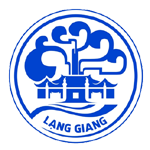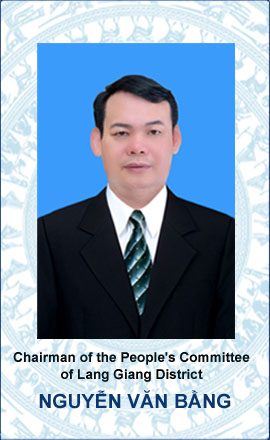Geographical location and potentials for economic development
Lang Giang, a mountainous district located in the northeast of Bac Giang province, has an important position as the gateway connecting the northeastern provinces with Bac Giang province which borders Huu Lung district (Lang Son province) and Yen The district to the north, Bac Giang city and Yen Dung district to the south, Luc Nam district to the east and Tan Yen district to the west. It covers a natural area of 24,401.91 ha, of which, agricultural land accounts for 75.58%, non-agricultural land accounts for 24%. The whole district has 23 commune-level administrative units (including 21 communes and 2 towns), in which Voi town is the administrative center of the district. The population of the whole district is 207,408 people (as of June 30, 2019), including about 63.4% people at the working age. The district party committee has 44 units with 8,233 party members, of which there are 29 party cells (23 commune and town party cells, 6 agency cells), 15 party cells under the district party committee; 416 cell branches under the Party cells (including 284 village and neighborhood cell branches).
Lang Giang district has a relatively favorable geographical location with a number of important national roads running through including National Highway 1A (Bac Giang-Lang Son), Bac Giang-Lang Son expressway, Hanoi - Lang Son, Kep - Ha Long railways. Lang Giang is one of four districts and cities of the province identified as a key socio-economic development, the district center is not far from industrial parks and large urban areas of the economic development triangle of Hanoi - Hai Phong - Quang Ninh. This densely populated place is the focal point of economic, scientific and technological exchange and investment attraction of the whole country, with a rapid urbanization rate which will be a large consumer market for agricultural products and other consumer goods.
2. Topography: Lang Giang has both hills and plains that can be divided into 3 main types of highland, lowland and plain topography, which facilitates the diversification of crops and livestock for a rich and diversified agricultural development.
3. Natural resources: Lang Giang district has all kinds of land resources, surface water sources, and forest resources. With 4 different soil groups of alluvial, gray infertile, valley, red and yellow soil, Lang Giang land is suitable for many crops such as rice, vegetables, short-term industrial crops, forestry. Taking advantage of surface water of Thuong River and Bung and Quat Lam canals flowing through the area and over 2,130 hectares of lake, dams and small ponds, the water demand for agricultural and industrial production and daily life of the people in the district is always met. The whole district has 2,265.32 hectares of forest, of which production forest is 1,133 hectares, natural regeneration forest is 500 hectares, etc.
4. Culture: Lang Giang has a long developed cultural tradition with 230 different religious and belief establishments such as communal houses, temples, pagodas, shrines, documents, churches, etc., of which there are 19 national relics and 86 provincial ones. The typical relics include cluster of communal houses, pagodas and thousand-year-old Da Huong tree (Tien Luc commune); Phu Lao communal house, Trung Ha communal house (Dao My commune); Am communal house, church and Pham Van Lieu's grave (Xuan Huong commune); Thong pagoda, Bang temple of Literature (Nghia Hoa commune); etc. Lang Giang still maintains many typical art clubs such as: Then singing (Can Coc village), Soong Co singing (Cay village) in Huong Son commune; Quan ho in Phu Do village (Phi Mo commune), Voi street (Voi town), rowing club in An Ha commune and Dai Giap village, Dai Lam commune; Violin Club (Then village), Thai Dao commune. The festivals are preserved and promoted by the residential community, such as the Bung festival (Tan Thanh commune), the Tien Luc festival (Tien Luc commune), etc., which attract a large number of people and visitors from all over the world.
5. Economic development: The total production value of major economic sectors in 2018 (at 2010 fixed prices) reached VND 11,097.1 billion, the production value of major economic sectors increased by 17.4% , in which: The production value of industry - construction reached VND 4,870.8 billion, up 20.3%; production value of agriculture, forestry and fishery reached VND 2,348 billion, up 6%; production value of the service industry reached VND 3,878.3 billion, up 21.5%. The economic structure continued to change positively, the proportion of agriculture, forestry and fishery was 22.32%; the proportion of industry – construction was 43.88%; and the proportion of services was 33.8%. Total social development investment capital was VND7,500 billion, reaching 180.7% of the plan. In the district, there are 07 industrial clusters with 11,060 employees, the average income was about 5 million VND/person/month.










